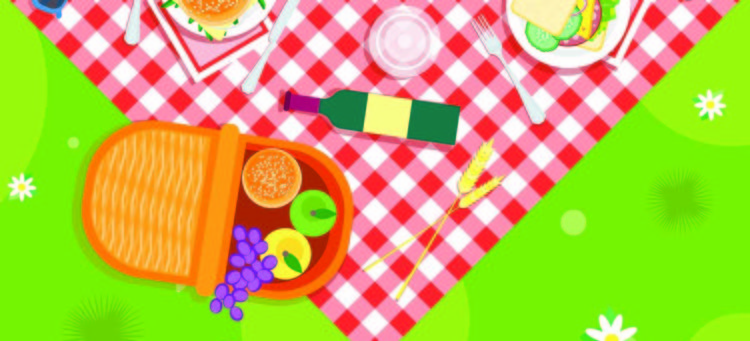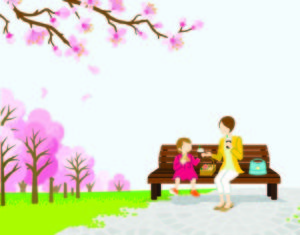
Conversations
Picnics: Unpacking the Picnic
BY MARKWELL LYON
June, 2018
History shows that picnics have been nourishing us long before we had a word for it—and in more ways than one.
Whether it’s in a scenic rural destination, a city park, or just your own backyard, there’s something special about enjoying food outside with your favourite people. Besides being a great opportunity to socialize, picnics are a celebration of nature and green spaces. And they’re healthy for us, too—the fresh air and vitamin D from sunshine helps lower blood pressure and the stress hormone cortisol. (Remember this as you’re helping yourself to that second piece of lemonmeringue pie. You’re welcome).
Even the word “picnic” conjures pleasing images: woven baskets, a checkered blanket, spreads of delicious food, grassy fields, family, friends, sunshine, scenery… maybe a few ants. It’s all part of the fun. According to the 2012 Canadian Nature Survey, “picnicking or relaxing in nature” is the most popular outdoor activity in the country, with 71% of respondents (78% in Alberta) having done so the previous year. In short, we like our picnics.
But is it possible that life in the fast lane could make picnics a nostalgic thing of the past? At a time when families are busier than ever, and in an age of distraction (digital or otherwise), it can be too easy to retreat indoors and into ourselves, even when the sunshine is calling. The effort of dropping everything to carve out time in the day, packing up the kids, prepping the food, choosing a site that’s relatively quiet and comfortable—it can all seem like too much of a bother. But the chance to unwind and unplug is all the more reason to set aside time and mental space for a meal outdoors. It’s an ideal way to slow down, live in the moment, get grounded, and create authentic, lasting memories.
You Say Tomato…
We’ve been picnicking longer than we’ve had a term for it—at least in English. The word comes from the French pique-nique, which first appeared in the late 17th century and may have been derived from piquer, which means “to pick” and nique, “a little thing.” In both English and French, the term originally described an indoor group meal, often over cards, conversation, and wine, where upper-crust attendees each contributed something to the meal. (Today, we might call this a potluck.) So when did picnicking move outdoors and become a “thing” in its own right? Well, another theory is that the word comes from pique un niche, which means “pick a place” (with the insinuation being outdoors). Regardless, the picnic we know today—a relaxed group meal outside—took off in the 1800s when people of all classes started making outdoor meals a leisurely pursuit.
But even as far back as the Middle Ages, wealthy people around the world were feasting alfresco (Italian for “in the cool air”), even if they didn’t have a proper word for it at the time. Then, as now, the eating often accompanied some other activity. In Europe, an elaborate feast might follow a hunt. Tapestries and other artwork from the period depict elegant multi-course meals at clothed tables attended by servants, replete with conversation, musical entertainment, and age-old drunken merriment. In East Asia, food and drink accompanied flower viewing parties, where people would gather to admire plum and cherry blossoms in the spring. This gave rise to the Japanese idiom hana yori dango, or “dumplings over flowers,” implying the real purpose of these parties wasn’t actually the scenery, but the food.
Under the Cherry Blossoms
A St. Albert mother of two, we’ll call her Megumi, talks about what defines a picnic for her. She’s Japanese, her husband is from France, and they regularly visit both countries with their children. While she’s enjoyed many outdoor meals outside of Canada, she’s a little unsure at first when asked about her picnicking habits in St. Albert. “I guess I do because I take my kids to the spray park and we eat there. That’s picnicking, right?” she asks with a laugh. “It feels good being out in the open air, and looking at nature, and enjoying the sun.”
Megumi’s earliest memories of picnicking are infused with cherry blossoms. Those flower-viewing outings we mentioned earlier, known as hanami, were a staple of her childhood in Japan.
“I guess it’s something I grew up with,” she says, looking back. “Every year we did that. It’s more like a festival, like Christmas. It’s the same feeling.”
The centuries-old tradition is still very popular in Japan and Korea, as ornamental add hyphen: cherry-tree-lined streets and parks explode in riots of pink and white every spring.
Though the scenery is certainly something to see, it’s often the outdoor meal amid all of that natural beauty that draws out the experience and makes it more memorable. On such outings, bento boxes take the place of picnic baskets. The food in these packed meals can vary, but often include rice, pickled vegetables, and fish or meat. As Megumi notes, the food often reflects the time of year: “Japanese people really care about the four seasons,” she explains. “Every season has different ingredients.” Hanami bentos feature spring vegetables, like bamboo shoots, and plenty of pink: think salmon or shrimp sushi, or dyed rice dumplings. “That’s how we appreciate spring and the arrival of the cherry blossoms.”
Under the Tuscan Sun (and Hwy 401)
Anyone who has spent a beautiful day longingly looking out of an office or school window, wishing they were out there, knows the pull of a picnic. It may simply be a matter of getting back to our roots. Picnics bring together friends and family, the outdoors, sunshine, games, a good time, great food—and in the process touch on something deeper. This is what Tina Powell, author of Picnic in Pisticci, calls a “longing for a simpler time.” The Toronto-based author was inspired to write her book ahead of a visit to southern Italy, her family’s hometown. Already a lifelong fan of picnics, she thought a picnic there would be a good idea. “This got me thinking about all the wonderful picnics I had enjoyed and the valuable lessons I had learned while picnicking,” Powell explained. That’s not to say that a picnic ought to be a learning experience, but rather that these unassuming outings have a power over us that is more affecting than we realize—they help shape us and create memories that stay with us for a lifetime.
Powell’s picnic in southern Italy, in contrast to Megumi’s cherry blossoms, was perhaps less picturesque, but just as memorable. Having to contend with 40°C heat and a dearth of shade trees or grass in the ancient town, her party eventually sat down for a meal of crusty rolls, Italian meats and cheeses, watermelon, and wine in a neglected municipal park… and they had a great time. The experience paralleled one of Powell’s childhood picnics where the setting couldn’t be more different: a fly-plagued berm alongside a busy off-ramp in Ontario. Not as romantic as the Italian countryside, but it was still a fun experience she would never forget.
Transcending Culture
While we don’t recommend grassy berms beside highways, the beauty of a picnic is that it’s a simple activity, and one that can be enjoyed almost anywhere. Aside from regional variations in food, the season, and the scenery, picnicking is essentially the same the world over.
In the end, it’s the ingredients that make the dish.
“It’s friends and family getting together and enjoying nature,” says Megumi. It’s a sentiment that Powell agrees with: “In my experience, picnicking transcends all cultures.”
In a world that seems to be moving ever faster, there’s something replenishing about going offline and slowing down, even for just a few hours, and a picnic is the perfect excuse to do just that. Powell notes, “I am a firm believer that today’s fast-paced, technology-driven world needs more picnics.” Even with 1,500 words, we couldn’t have said it better. t8n
What a Difference a Place Makes
Looking for somewhere to take your next picnic? Check out any of these local parks.
Lions Park Play structures, swings, outdoor fitness equipment, tables, firepits, and two shelters that can be reserved for large groups. (Go early and stake out your pit if you intend to grill.)
Red Willow Park A picturesque riverside setting near Woodlands Water Play Park with a spray park, play structure, skate park, and nearby ‘beach’ volleyball courts.
Kingswood Day Area A quieter patch with plenty of grass for picnicking, plus hiking and birding
opportunities at the adjacent Riverlot 56.
Riel Recreation Park Equipped with tables and firepits, perfect for a post-game picnic.














